GIKKU : Gojuryu Internatonal Karatedo Kobudo Unioin YUZENKAI Hi HiHistory to Yuzenkai 勇善会への道 last up date MAY21, 2025 HOME |
||||
|---|---|---|---|---|
 . |
||||
| ..It is presumed that Gojo-Ryu Karate has made from the following six roots
.剛柔流には6つのルーツがあると考えられている。 1.Martial arts practiced in the kume village, Naha, dating back to 1392. 1392年の中国(明)からきた大量の技術者集団が移住した那覇久米村の武術 2.The martial arts of Wai Shinzan, introduced from China in the 19th century. ワイ・シンザンと称される中国人のもたらした武術 3.The martial arts of Tou Ruko, who was Higaonna's teacher in China during the 19th century. トゥ・ルーコウ(ルール―コ―)と称される中国人のもたらした武術 4.The martial arts Chojun Miyagi studied in China over 90 years ago. 宮城長順が上海で研究した武術 5.The martial arts developed by Miyagi himself. 宮城長順の創作した技術 6.The martial arts of Choyu Motobu and Kenki Go in pre WW2." 戦前に沖縄唐手倶楽部で本部朝勇や呉賢貴がシェアした武術 以下のabout2とabout3は勇善会に伝わる口碑と照らして最も説得力のある金城昭夫氏の大著『空手伝真録 上・下』を主要な参考文献とした。 "This explanation is largely based on Shihan Akio Kinjo's masterpiece, Karate Denshinroku;The Record of the True History of Karate, as his research is highly persuasive when viewed through the lens of the folklore passed down through my lineage." About1 1392年中国(明)皇帝の命で那覇へ大規模な移住があった。久米村に居住区を形成したため「久米三十六姓」と呼ばれた。「三十六」は多数の比喩である。彼らは学問、芸術、外交、文学、工学、建築などの専門技術者で、それぞれの技術を家伝として継承した。武術も付随して渡来したと想定されている。 .Mass migration came from China to Naha in 1392. They formed the concession in the kume village. They were called "the 36 families in kume-village(久米三十六姓)". ..The word "36" is a metaphor of "so much". 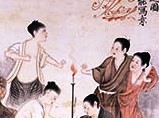 ..Each families had professional skill , study, art, diplomacy, literature, engineering, the building and so on.They were passed down only from father to son. The roots of Karate was
also one of such professionals skill. ..Each families had professional skill , study, art, diplomacy, literature, engineering, the building and so on.They were passed down only from father to son. The roots of Karate was
also one of such professionals skill.. 剛柔流の道場には武神「九天風火院田都元帥」(九天風火院田都元帥)が祀られている。この神は中国南方で信仰される道教の芸能の神である。 In the Goju-Ryu Dojo, the martial arts god "Busa-ganashi:Kyu-Ten-Fu- Ka- In- DenTo-Gensui" (九天風火院田都元帥)has been enshrined.It is the god of the folk customs belief imported from China by them. |
||||
About2 Who was “Wai Shinzanワイシンザンとは何者か。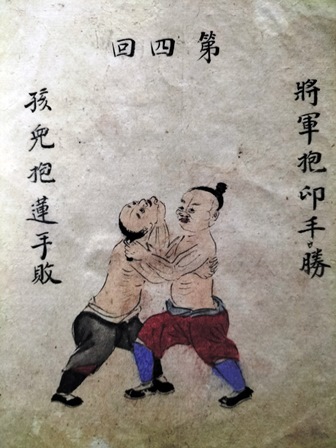 剛柔流の祖、東恩納寛量の師である新垣世璋が師事したワイ・シンザンは1838年と1866年に琉球へ来た中国人武官王打振(Uòng Dâ Tìng;ウォン・ダーティン)と推定されている。沖縄で伝承されている「ワイ・シンザン」という名はワン師父(Uòng
Sê Hṳ̄;ウォン・シェーフ)の音便化で型名の「ワンシュウ」や「ウンス―」もウォン・シェーフに由来し「ワンカン」は王武官(Uòng Mṳ̆
Guăng;ウォン・ムー・グァン)の音便と考えられる。「沖縄伝武備志」に羅漢拳の名人として引用されている王登岳(Uòng Dĕng Gák)もウォン・ドゥン・ガクの別名と推定されている。 剛柔流の祖、東恩納寛量の師である新垣世璋が師事したワイ・シンザンは1838年と1866年に琉球へ来た中国人武官王打振(Uòng Dâ Tìng;ウォン・ダーティン)と推定されている。沖縄で伝承されている「ワイ・シンザン」という名はワン師父(Uòng
Sê Hṳ̄;ウォン・シェーフ)の音便化で型名の「ワンシュウ」や「ウンス―」もウォン・シェーフに由来し「ワンカン」は王武官(Uòng Mṳ̆
Guăng;ウォン・ムー・グァン)の音便と考えられる。「沖縄伝武備志」に羅漢拳の名人として引用されている王登岳(Uòng Dĕng Gák)もウォン・ドゥン・ガクの別名と推定されている。“Wai Shinzan” was thought the Chinese martial artist and the teacher of Aragaki Seisyo 新垣世璋(teacher of Higaonna Kanryo). His real name seems to be "Uòng Dâ Tìng "(王打興;王重興1793?~1894?). He came to Okinawa twice, once in 1838 and once in 1866 as the military arts executive accompanying representatives of the Chinese government. The pronunciation “Wai Shinzan” originates from “Uòng Sê Hṳ̄:王師父” (meaning; Wang sensei). Wai Shinzan had kept close relations with karate masters in Okinawa. Now he is regarded as one of the founders of Gojo-Ryu. ..In the “Bubishi” called the Bible of Gojo-Ryu , the philosophy of Wai Shinzan had been recorded .As a side note, in this book Wai was written by his another name "Uòng Dĕng Gák;王登岳.” Wai Shinzan's influences is also seen in Syuri-te. Matsumura Sokon was his student. The Katas, “Wankan”, “Wansyu”, and “Unsu” originate in the alias named Uòng Sê Hṳ;王師父 (meaning Wang sensei). “Wankan” means “Uòng Mṳ̆ Guăng;王武官”. Bukan means the martial bureaucrat. “Wansyu” was from “Wang Shifu”. Unsu was form “Uòng Sê Hṳ̄”. Incidentally, he was a famous martial artist in the Chinese “Fujian White Crane ”. As a result, Karate was influenced from this type of Kung Fu. Note: Wai Shinzan = Uòng Dâ Tìng= Uòng Sê Hṳ̄ = Uòng Dĕng Gák |
||||
| About3 Who is" RuRuKo"? .. Strangely, the correctly name of Higaonna's Chinese master is unknown. Another pronunciation"RyuRyuKo", "Tou Ryuko " and "TouRyuKo" have been handed down.There are two theories considered reasonable in light of the oral tradition passed down by Yuzenkai. ..また剛柔流の祖として口伝されてきたルールーコー(リュウリュウコウまたはトゥールーコウともいわれる)は勇善会に伝わる口碑と照らして妥当と思われる2つの説がある。 ひとつは東恩納寛量自身を指すと言う説。つまり彼が中国福州で量量(ルール―;Liòng Liòng;原音はリォン・リォン) )とよばれていたことに由来するという説である。One theory is that Kan"ryo" Higaonna was called by such a nickname "RuRuルール―"or"RyuRyu"in China.There is a custom in China to call young people by such nicknames. .もうひとつは比嘉世幸がトゥールーコーと発音して伝えた人物だが、白鶴拳の拳譜に残る鄭礼公(Dìng Léi Gŭng;ディン・レイ・グン)であるとする説である。勇善会はこちらの説を支持している。 Another theory is that "TouRyuKo" is Dìng Léi Gŭng"鄭礼公", the expert of “"White Crane(白鶴拳)" The name Tou RyuKo is information from Seiko Higa. Because Higa's father was a cousin of Kanryo Higaonna, Higa inherited a lot of information about Higaonna. Chojun Miyagi, by contrast, knew little about Higaonna's master. Therefore, I think it is best to infer from the information Seiko conveyed.There are other theories, but Yuzenkai adopts the Te le Kong theory to respect Seiko Higa's oral history. →refer to Dìng Léi Gŭng. |
||||
| The founders to Gojuryu Karate | ||||
Kanryou Higaonna 東恩納寛量(1853 – 1916) ..那覇手中興の祖といわれる。剛柔流の流祖。許田重発、宮城長順、比嘉世幸の師で三戦、セーサン、サンセール、ベッチュウリンを伝えた。 "Kanryo Higaonna had three notable students: Juhatsu Kyoda, Chojun Miyagi, and Seiko Higa. Higaonna transmitted four katas: Sanchin, Seisan, Sanseru, and Betturin. His Betturin differs somewhat from today’s Goju-ryu Suparinpei. There is record proving that these katas existed in Okinawa before Higaonna’s time. 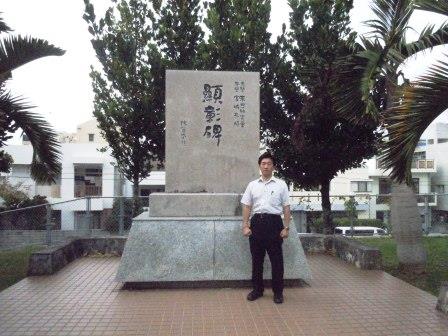 At the place (Kume town, Naha city) where Goju-Ryu was born, there is a commending stone monument dedicated Kanryo Higaonna and Chojun Miyagi. Needless to say, they are initiators of Gojuryu. 沖縄県那覇市、剛柔流空手道発祥地に建つ東恩納寛量と宮城長順の顕彰碑 October 3, 2013. .  .東恩納の師が前述のマヤー新垣(猫のような身のこなしの新垣)と呼ばれた新垣世璋である。新垣は1866年の冊封使節歓迎演武において通訳を務めセーサン、釵組棒、シソーチンを演武した。彼はワイ・シンザン(王打興Uòng Dâ Tìng=王師父 Uòng Sê Hṳ̄ )に師事した。「新垣のウンス(王師父) 」と称する型が剛柔流の一部に伝承されている。(写真:首里手のウンスとは別型). .東恩納の師が前述のマヤー新垣(猫のような身のこなしの新垣)と呼ばれた新垣世璋である。新垣は1866年の冊封使節歓迎演武において通訳を務めセーサン、釵組棒、シソーチンを演武した。彼はワイ・シンザン(王打興Uòng Dâ Tìng=王師父 Uòng Sê Hṳ̄ )に師事した。「新垣のウンス(王師父) 」と称する型が剛柔流の一部に伝承されている。(写真:首里手のウンスとは別型). .Kanryo Higaonna is said to have learned Naha-te from Seisyo Aragaki新垣世璋Seisho Aragaki (1840–1920). This makes him, in a way, a disciple of
TouRyuko's disciple. According to records, Aragaki served as an interpreter for the Chinese mission to Okinawa in 1866, where he performed Seisan, Shisochin, as well as Sai and Bo kumite at the welcoming ceremony. Today, a kata called 'Aragaki no Unsu' is preserved in one of Seiko Higa’s lineages. While it shares the same pronunciation as the Shuri-te kata 'Unsu,' it is a completely different kata. .Kanryo Higaonna is said to have learned Naha-te from Seisyo Aragaki新垣世璋Seisho Aragaki (1840–1920). This makes him, in a way, a disciple of
TouRyuko's disciple. According to records, Aragaki served as an interpreter for the Chinese mission to Okinawa in 1866, where he performed Seisan, Shisochin, as well as Sai and Bo kumite at the welcoming ceremony. Today, a kata called 'Aragaki no Unsu' is preserved in one of Seiko Higa’s lineages. While it shares the same pronunciation as the Shuri-te kata 'Unsu,' it is a completely different kata.'Unsu' means 'Kata of Uòng Sê Hṳ (Uòng sensei),' and I believe there are at least three different kata that claim to have originated from Uòng. . 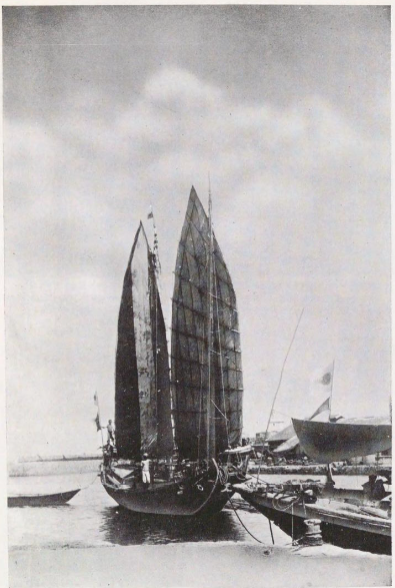 東恩納は中国に10年から30年滞在しリュウリュウコウという武術家から学んだと言われてきたが最近はその滞在は3年ほどで商売が主目的だったという説が有力である。私は半世紀以上昔、師から「リュウリュウコウが実在した証拠はない。東恩納寛量が大洪水の際に師匠の子を助け、そのお礼として武術を教わったという話は聞いたが、その師匠の名がリュウリュウコウだったという根拠はない。」と聞いたことがある。 東恩納は中国に10年から30年滞在しリュウリュウコウという武術家から学んだと言われてきたが最近はその滞在は3年ほどで商売が主目的だったという説が有力である。私は半世紀以上昔、師から「リュウリュウコウが実在した証拠はない。東恩納寛量が大洪水の際に師匠の子を助け、そのお礼として武術を教わったという話は聞いたが、その師匠の名がリュウリュウコウだったという根拠はない。」と聞いたことがある。It was once believed that Higaonna stayed in China for 10 to 30 years, learning Fujian white crane from the master named Ru Ruko (also known as Ru Ryuko or Tou Ryuko). However, a newer theory suggests that his stay in China was only about three years and primarily for business purposes (as seen in the photo of "Yanbaru ships" used for trade at the time). ..More than half a century ago, my old master told me there was no evidence of Ru Ryuko's existence. He heard that Higaonna helped save his teacher’s child during a great flood, which led him to learn Kung Fu from the teacher. But there is no proof that the teacher’s name was Ru (or Tou) Ryuko. ..Today, some Karate masters travel to China searching for evidence of Ru (Tou) Ryuko, but so far, he has not been found. What they are really debating is likely a misunderstanding of a Chinese master's name that resembles Ru Ruko. This is purely speculative, as there is no Kung Fu system directly linked to Goju-Ryu that has been identified. What is certain is that Kanryo Higaonna revitalized Naha-te, which was on the brink of disappearing, and passed it down to future generations. However, Goju-Ryu contains many kata and techniques that extend beyond his Naha-te tradition.  1905年に沖縄県で唐手(からて)が学校体育の単元のひとつに選定された。それに際して沖縄県学務課が会議をもったが出席者の1人の東恩納寛量が学務課と決裂して退席した。当局から「三戦」の教育的意義について批判されたらしい。 1905年に沖縄県で唐手(からて)が学校体育の単元のひとつに選定された。それに際して沖縄県学務課が会議をもったが出席者の1人の東恩納寛量が学務課と決裂して退席した。当局から「三戦」の教育的意義について批判されたらしい。当時の沖縄県内最高学府といえる県立第一中学と県立師範学校での唐手は糸洲とその人脈が担当するようになった。平安初段~5段は糸洲によって(写真:1902年)がそのさい教育用に創作された型である。 なお当時は部活動は剣道と柔道である。空手は体錬(体育)の単元のひとつであり、しかも必修単元になったのは昭和18年(1943年)であった。(「最後の一中生」沖縄県立第一中学校昭和19年入学同期生会) In Okinawa,Karate became the subject of the physical education in the secondary school from1905."Pinan(Heian)1to5" were made by Anko Itosu糸洲安恒 (photo:1902)for secondary school education. Incidentally, at a meeting of the Okinawa Prefectural Education Department in 1905 to discuss the introduction of karate into school education, Higaonna clashed with bureaucrats and Itosu and walked out.It seems that the authorities criticized the educational significance of 'Sanchin. →reference There by the introduction of Naha-te into school education was significantly delayed. In Okinawa, where there were no higher education institutions, the highest academic establishments were old-system junior high schools and normal schools (with junior high schools ranked higher). Karate instruction at these institutions was monopolized by Itosu and his lineage. However, extracurricular activities (club activities) consisted of kendo and judo, while karate was part of physical training (physical education) as one of the units, becoming a mandatory unit in 1943.   photo;Kentsu Yabu, the one of Kyoda's teacher,and his students at Okinawa Teachers college in 1905a.b.Yabu is an elite educator with an official teaching license, responsible for physical education (physical training). 写真はYabu is an elite educator with an official teaching license, responsible for physical education (physical training).(許田の師範学校の師)と沖縄師範学校の生徒。屋部は正規の教員免許状を持つエリートで担当は体育(体錬) 糸洲の傍系弟子のひとり船越(冨名腰)義珍は1922年に東京に移住し沖縄県人寮の管理人をしながら東京大学や慶応大学の学生に空手を教授した。「松濤」(しょうとう)とはのちに船越が住まいを構えた町の名である。 ..And Gichin Funakoshi冨名腰義珍 ,the student of Anko Itosu, migrated to Tokyo in 1922 and taught Karate to a lot of university students."Syoto" was the town name he lived. |
||||
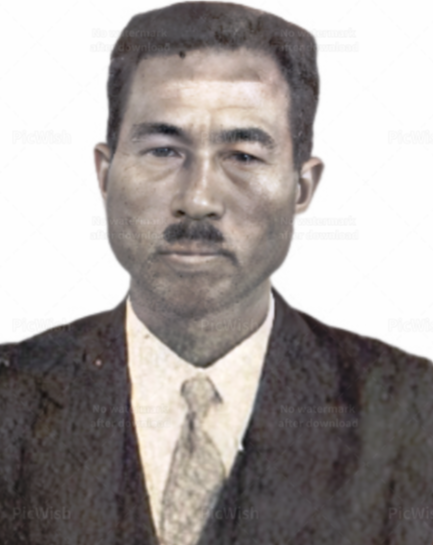 Juhatsu Kyoda 許田重発(1887-1968) Juhatsu Kyoda 許田重発(1887-1968)..泊小学校校長。東恩納寛量の最古参の弟子。宮城が名乗った剛柔流という名称に批判的で、さらに宮城が東恩納正統を称することにも懐疑的だった。昭和35年頃から東恩流(とうおんりゅう)を名乗り三戦、セーサン、サンセール、べッチューリン(スーパーリンペー)の4型に屋部憲通(彼の師範学校時代の師)のジオンと呉賢貴(那覇の茶商で白鶴拳の名人)のネ―パイを加えて教授した。戦前の沖縄でスーパーリンペーの公開演武を初めて行った。(1939年) 許田の最古の弟子に泉川寛喜(1908~1967)がいる。泉川の撃砕初段・二段、サンセール、セーサンにその影響つまり許田のもうひとりの師である屋部憲通の首里手の要素(鋭さ、速さ、離れた間合いから一瞬で詰める転身)が見られる。 ..Kyoda was the oldest student of Kanryo Higaonna. Tomari Elementary School Principal. He founded Touon-ryu due to a difference of opinion with Chojun Miyagi. The name 'Touon' is a variant pronunciation of 'Higaonna.' Kyoda did not modify Higaonna's techniques at all and preserved only six kata: Sanchin, Seisan, Sanseru, Pechurin (Betturin), Jion, and Nepai. Jion came from Kentsu Yabu (a soldier and sergeant, 1866–1937), and Nepai from Kenki Go (a tea trader, 1886–1940). Higaonna originally taught only four kata—Sanchin, Seisan, Sanseru, and Pechurin—so Kyoda was skeptical of the legitimacy and the numerous kata Miyagi introduced. Observing Kyoda’s Touon-ryu kata today, we can infer that Miyagi made significant additions and improvements to Higaonna’s Naha-te.  F 許田の職業は小学校の校長。いわゆる知的エリート層だった。写真は『沖縄の名士・風景大観』(1935年)に掲載されたもの。ちなみに空手家は1人も掲載されていない。一般的に空手家は当時は社会的名士というものではなかった。 F 許田の職業は小学校の校長。いわゆる知的エリート層だった。写真は『沖縄の名士・風景大観』(1935年)に掲載されたもの。ちなみに空手家は1人も掲載されていない。一般的に空手家は当時は社会的名士というものではなかった。From "Photograph Collection of Famous People and Landscapes in Okinawa"(1935). Kyoda is the only karate figure featured in this photo book. An intellectual, he served as the principal of Tomari Elementary School. While he was a karate master to us, he was first and foremost a respected educator."Overall, karate practitioners were not considered social dignitaries at the time." 1936年に沖縄県学務課は唐手(からて)の名称を空手(からて)に正式変更した。 In 1936, the Okinawa Prefectural Bord of Education changed the letter of Karate ,唐手to空手.  1939年に念願の大日本武徳会沖縄県支部(写真)が設立された。その記念演武会のプログラムによると許田がスーパーリンペー、宮城長順が転掌、比嘉世幸と新里仁安がセーサン、福地清幸がシソーチン、神山恒栄がセイエンチン、高嶺朝睦がサイファを演武したことが分かる。大日本武徳会で演武した彼らは当時の沖縄空手界を代表する人々だったといえる。なおプログラムに流派名は記載されていない。本土で流派名がさかんに用いられていたことと対照的である。 1939年に念願の大日本武徳会沖縄県支部(写真)が設立された。その記念演武会のプログラムによると許田がスーパーリンペー、宮城長順が転掌、比嘉世幸と新里仁安がセーサン、福地清幸がシソーチン、神山恒栄がセイエンチン、高嶺朝睦がサイファを演武したことが分かる。大日本武徳会で演武した彼らは当時の沖縄空手界を代表する人々だったといえる。なおプログラムに流派名は記載されていない。本土で流派名がさかんに用いられていたことと対照的である。 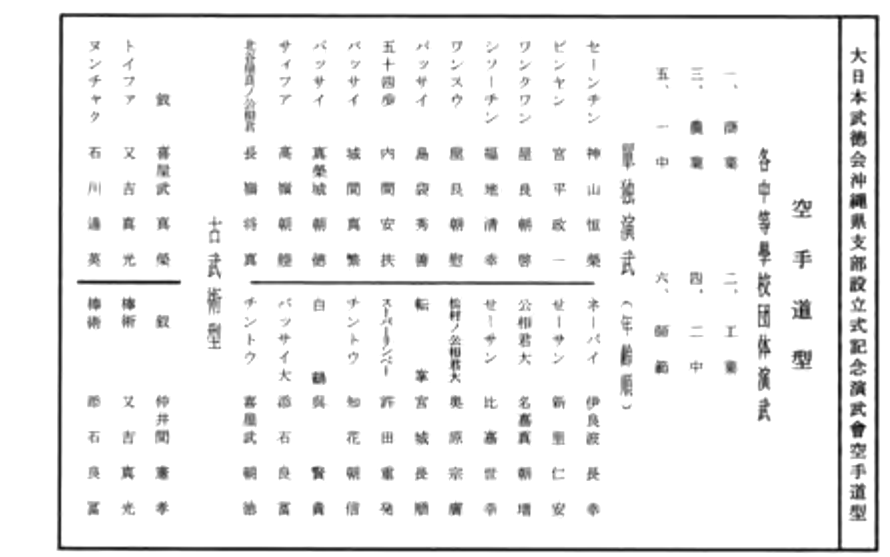 公的な記録に残る最古のスーパーリンペーの演武者が許田だったことは当時彼が東恩納門下の最高権威であったことを意味する。後年許田はスーパーリンペーではなくべッチュウリン(百歩連)と称した。ただしベッチュウリンと現在のスーパーリンペーは同内容ではないので1939年に彼が演武したスーパーリンペーはどのようなものだったのか興味深い。このプログラムには他に伊良場長幸のネーパイ、呉賢貴の白鶴(ハッファ;カクファ)などもあり興味深い。 公的な記録に残る最古のスーパーリンペーの演武者が許田だったことは当時彼が東恩納門下の最高権威であったことを意味する。後年許田はスーパーリンペーではなくべッチュウリン(百歩連)と称した。ただしベッチュウリンと現在のスーパーリンペーは同内容ではないので1939年に彼が演武したスーパーリンペーはどのようなものだったのか興味深い。このプログラムには他に伊良場長幸のネーパイ、呉賢貴の白鶴(ハッファ;カクファ)などもあり興味深い。..At the1939demonstration marking the establishment of the Dainippon Butokukai Okinawa branch, Juhatsu Kyoda performed 'Suparinpei,' Chojun Miyagi demonstrated 'Tensho,' Jinan Shinsato and Seiko Higa performed 'Seisan,' and Seiko Fukuchi performed 'Shisochin.' This event served as proof, both to Kyoda and others, of his position as the orthodox successor of Kanryo Higaonna’s teachings. Kyoda later referred to this kata as 'Pechurin' (meaning '100 steps'), and claimed it was distinct from Suparinpei, though at the time he called it 'Suparinpei.' This is the first recorded public performance of Suparinpei. photo;1939 demonstration program 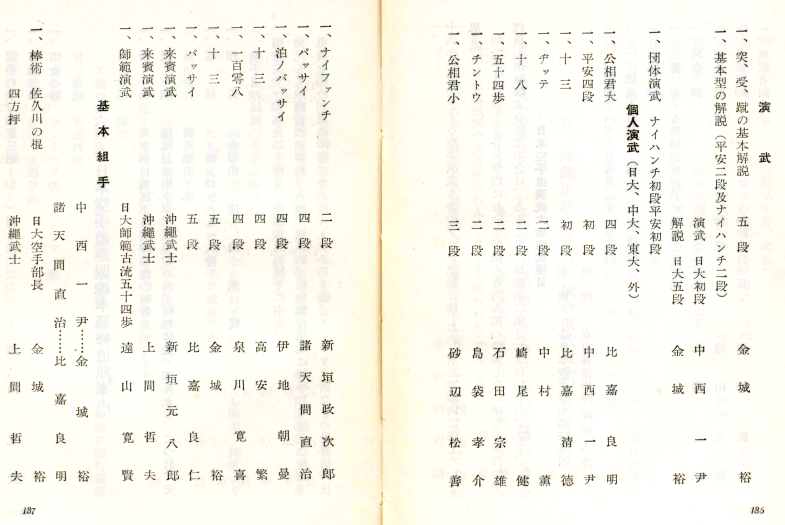 許田の演武から2年後の1941年、彼の弟子である泉川寛喜(1908-1967)四段(当時)が横浜市鶴見の沖縄県人会館で開催された本土初の「日本空手道演武大会」でスーパーリンペーを演武した。これは本土における同型の公的演武の最初の公的記録である。表記は一百零八。 許田の演武から2年後の1941年、彼の弟子である泉川寛喜(1908-1967)四段(当時)が横浜市鶴見の沖縄県人会館で開催された本土初の「日本空手道演武大会」でスーパーリンペーを演武した。これは本土における同型の公的演武の最初の公的記録である。表記は一百零八。式次第を見ると沖縄の空手家に段位はなく単に沖縄武士とされている。空手の段位制度は本土で創始されたもので沖縄には存在しなかったからである。 In 1941, Kyoda's top student, Kanki Izumikawa, (4th Dan), demonstrated Suparinpei at Japan's first karate demonstration, held in Yokohama, which brought together karate practitioners from both mainland Japan and Okinawa. Notably, the Okinawan karate-ka were simply referred to as Okinawan samurai and did not hold Dan ranks. This highlights an important point in karate history: the Dan ranking system was established on the mainland and did not originate in Okinawa." 泉川は比嘉世幸の高弟でもあり、本土で最初の組織的な剛柔流道場を開始した先駆者である。許田との関係も晩年まで続き前述のとおり泉川の撃砕初段、撃砕二段、サンセール、セーサンに許田の影響が見られる。 "One of the students he taught was Kanki Izumikawa (泉川寛喜;1908–1967), the top disciple of Seiko Higa and one of the first Okinawans to establish organized Goju-ryu dojo activities in mainland Japan. Their karate relationship continued even after the war. Kanki later modified the Gekisai Dai Ichi and Gekisai Dai Ni kata, originally created by Chojun Miyagi for school education in 1940, drawing on Kyoda's Sanseru. He renamed these modified versions Gekisai Shodan and Gekisai Nidan."It is an element of Shuri-te, derived from Yabu Kentsu, another mentor of Kyoda, characterized by sharpness, speed, and the ability to close the distance instantly from a long range through swift movement |
||||
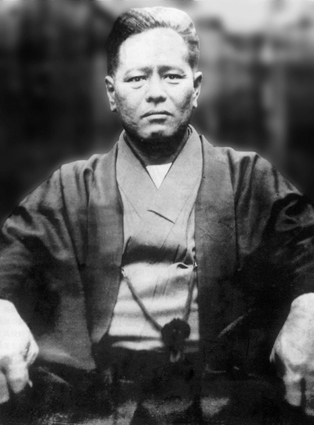 ..Chojun Miyagi 宮城長順(1888-1953) ..Chojun Miyagi 宮城長順(1888-1953)..東恩納寛量の晩年を支えた那覇の素封家。那覇商業学校に1929年から1937年まで嘱託職員として勤務し唐手を指導した。(1937年から"空手"標記) 伝統主義者ではなく改革者だった。東恩納の那覇手を土台に予備運動や補助運動を開発し体系化した。それに伴い東恩納の型を改編し、さらにセ―パイ、サイファ、セイエンチン、クルンンファを追加し撃砕、転掌を創作した。 ..彼の目的は沖縄のローカルな武術唐手を柔道や剣道と並ぶ日本の武道として普及し国民体育とすることだった。糸洲の教育空手と同様の趣旨といえる。講道館の加納治五郎と知遇を得たことで京都の大日本武徳会に出入りした。 「剛柔流」の命名者とされるが真実は昭和4年(1929年)に宮城の弟子新里仁安(しんさとじんあん1901~1945) が大日本武徳会本部で演武するさい日本の武道家から流派名を問われ便宜的に返答したのを宮城が追認したものである 柔道や剣道は富国強兵の国策を背景に柔術諸流派や剣術諸流派を止揚して誕生した近代的な武道であり、それらから見ると他の武術は前近代的な段階に止まる存在であったから、そうした質問が唐手にも寄せられたのは自然である。 この便宜的な「剛柔流」名が大日本武徳会を通じて流布したため他の那覇の空手家も本土進出の際「剛柔流」を用いると万事手っ取り速くなった。大阪に進出した摩文仁賢和も首都圏へ進出した泉川寛喜も那覇手ではなく「剛柔流」を使用した。 しかし沖縄では流派名はなく柔道剣道に比肩する日本武道として団結しようという気運が高まっていたから、遠山寛賢が語るように宮城や摩文仁が流派名を名乗ったことは沖縄の動向に大きく反する行動だった。 全国中等学校等教職員名簿」によると宮城は1929年から1937年まで那覇市立商業高校の唐手教授(法令的上は嘱託実習助手)を務めた。商業学校は当時の教育制度では旧制中学や師範学校より格下である。前述の1905年の学務課会議を東恩納が退席したことに起因する糸洲一派の興隆の後塵を拝した宮城の立ち位置が伺われる。ただし糸洲一派も宮城も身分は嘱託実習助手で同格であり、学歴と教員免許状を有する教諭とは地位も処遇も大きな差があった。 1937年の職員名簿では標記が「空手」に変更されている。前年の沖縄県学務課の決定に基づく変更だろう。 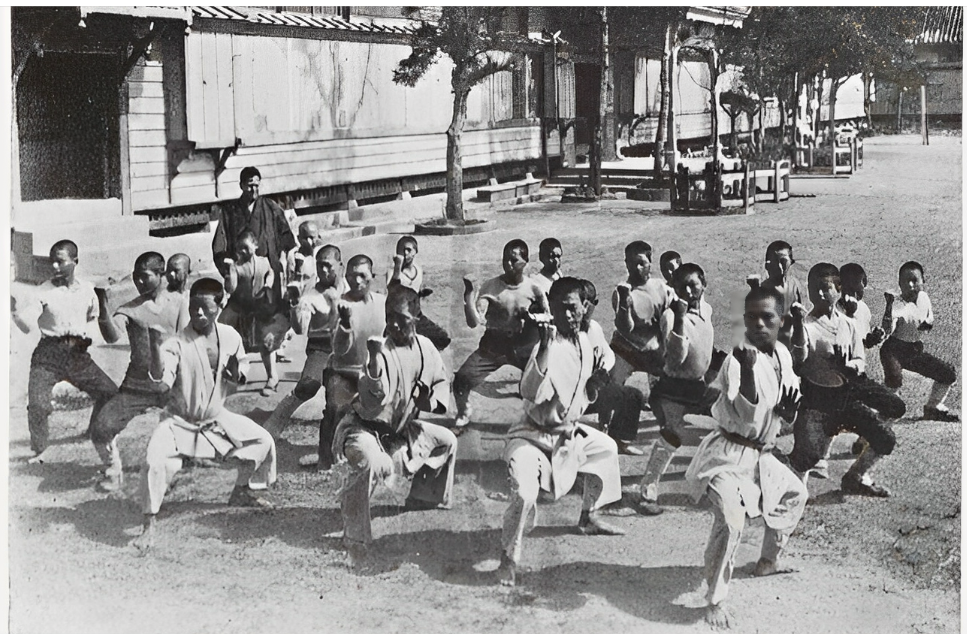 . . At Naha Municipal Commercial High School,the 1937. Because Judo was a required subject, the students wore Judo-gi.那覇市立商業学校。戦前の中等教育では男子は剣道か柔道が必修だった。生徒が柔道着に"商空"と記していることから1937年以降の撮影と推定される。 戦前の中等学校等職員は国に登録され服務は厳しく管理されていた。宮城がこの時期に京都で空手指導に専念したという説があるがそれは服務上できない。正確には那覇商業学校の夏休みや冬休みに京都を訪れたという程度である。→参照 そのとき指導した学生等のメンバーの1人に山口剛玄がいて、その一派を中心に戦後に剛柔会が結成され、それが今日の全空連剛柔会になった。 第二次世界大戦末期の沖縄戦(1945.3月~6月)で壊滅的な被害を受けた沖縄は1972年までアメリカ軍の統治下で辛酸をなめた。宮城の早すぎる死(1953年、64歳)もあり高度経済成長に乗って海外普及する本土の剛柔流との間に解離が生じた。. ..Miyagi was a very wealthy merchant in Naha who supported Kanryo Higaonna throughout his life. He served as a part-time staff member at Naha Commercial School from 1929 to 1937, teaching karate to the students. His goal was to elevate Okinawan Tode to the status of a national physical discipline in Japan, alongside Judo and Kendo, and, like Itosu's educational karate, to spread it throughout the country. Through his friendship with Jigoro Kano of the Kodokan, he gained access to the Dai Nippon Butoku Kai in Kyoto. He was more of a reformer than a traditionalist, driven by ambition to study Naha-te, formalize its theory and system. His goal was to spread it across Japan as a form of Japanese Budo, believing this would elevate the status of Okinawa and its culture. ..He incorporated new and original elements into Naha-te, building on Higaonna's teachings. He modernized the Sanchin kata, created the Tensho kata, invented various tools and training methods, and developed warm-up exercises and systematic training routines. Additionally, he created Gekisai, Sepai, and Saifa, while modifying katas like Sanseru, Seienchin, Kururunfa, and Suparinpei.He was an educator at heart, learned, and inquisitive. He was presumed to have collected a large number of Kata, but he tried to sift through them to create a system of Gouryu's theory and practice based on Sanchin and Tensyo.. Miyagi is often credited as the one who named "Goju-Ryu," but in truth, it was his student Jinan Shinzato (1901–1945) who, when asked by Japanese martial artists about his style during a demonstration at the Dai Nippon Butoku Kai headquarters in 1929 , gave the name "Goju-Ryu" as a matter of convenience. Miyagi later approved this answer.Judo and kendo are modern martial arts that emerged as part of a national policy to strengthen the country, having synthesized and transcended the various traditional schools of jujutsu and kenjutsu. From that perspective, other martial arts that remained at the stage of “techniques” within individual styles were seen as pre-modern. Therefore, it was only natural that such questions were raised. ..However, because this provisional name "Goju-Ryu" spread through the Dai Nippon Butoku Kai, other Naha-te karate practitioners also found it difficult to operate in mainland Japan without using the name "Goju-Ryu." The reality is that Kenwa Mabuni, who expanded to Osaka, and Kanki Izumikawa, who moved into the Tokyo area, were compelled to use "Goju-Ryu" instead of "Naha-te." In Okinawa, ryuha;style names did not exist at the time, and there was a strong momentum toward unifying karate rather than dividing it. As Kan Ken Toyama expressed, there was a shared concern that naming styles would lead to fragmentation in karate. In that sense, Miyagi’s actions were a "breaking the agreement " and became a trigger for the division of karate.  According to "the National Directory of Secondary School Teachers",
Miyagi served as the "Karate" (唐手) instructor at Naha Municipal
Commercial High School from 1929 to 1937. His official status under the
law was that of a practical assistant. From 1937 onward, the term "Karate"
(唐手) was replaced with "Karate" (空手).This change is likely based
on a decision made by the Okinawa Prefectural Educational Affairs Division
the previous year. According to "the National Directory of Secondary School Teachers",
Miyagi served as the "Karate" (唐手) instructor at Naha Municipal
Commercial High School from 1929 to 1937. His official status under the
law was that of a practical assistant. From 1937 onward, the term "Karate"
(唐手) was replaced with "Karate" (空手).This change is likely based
on a decision made by the Okinawa Prefectural Educational Affairs Division
the previous year.In the Japanese education system, commercial schools were ranked lower than old-system junior high schools and normal schools (in terms of entrance exams, duration of study, and post-graduation paths), which reflects Miyagi’s standing at the time. Notably, he did not use the term "Goju-ryu," which he had begun using on the mainland, at that school. Incidentally, the position of karate instructor at that time was treated as a part-time assistant instructor, a role far inferior in status and treatment compared to regular teachers who were required to have academic degrees and official teaching licenses. There is a popular misconception that Miyagi devoted himself to karate instruction in Kyoto, but that is incorrect. The truth is that Miyagi taught karate in Kyoto during the summer vacation of the commercial school.There was Dainippon Butokukai Honbu in Kyoto.He taught Goju-ryu to university students from Kyoto and Osaka in Kyoto. After the war, it was spread both domestically and internationally by Gogen Yamaguchi and others, and became today's popular Goju-ryu.He acquired the title of "Kyoshi" .It was the first time in karate. He regularly taught karate at a university in Kyoto.Gogen Yamaguchi 山口剛玄was one of unversity student . Teaching in university make his social position improved. Okinawa suffered devastating damage during World War II. Furthermore, it was under American military occupation until 1972, which hindered the international development of Okinawan karate. Additionally, Miyagi's premature death in 1953 at the age of 64 created a barrier between the economically growing Goju Ryu on the mainland and Okinawa. Miyagi's vision of fully theorizing and systematizing Goju-ryu karate remains incomplete. It is our responsibility to continue working toward this goal, a mission that goes beyond the realm of sports and the Olympics." Three important messages from Miyagi had been carved for the other side of this monument. "It is important to understand that the essence of Goju-ryu Karate lies within its kata." 2.剛柔流空手道は己の内に天地自然の調和を表現すべきなり "Goju-ryu Karate-do should express the harmony of heaven, earth, and nature within oneself." 3.剛柔流空手道は徳の道を追求するものなり "We should develop a strong moral character through the practice of Goju-ryu Karate." 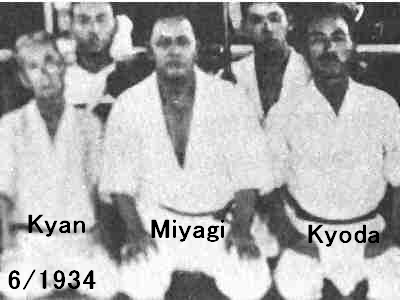 Chotoku Kyan,Chojun Miyagi,Juhatsu Kyoda in 1934 左から喜屋武朝徳、宮城長順、許田重発 1934.6 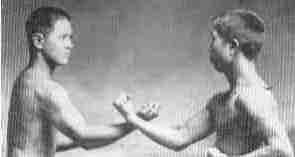 Young Kyoda and Miyagi. They were rival at the same time as the relation like the brother it.宮城長順と許田重発  kanken Toyama(1888-1969)遠山寛賢(親泊寛賢) kanken Toyama(1888-1969)遠山寛賢(親泊寛賢)前述のとおり宮城は剛柔流を名乗り摩文仁賢和は糸東流を名乗った。本土製の空手から和道流も名乗りをあげた。 だが沖縄に流派名は存在せず、むしろ教育現場を中心に柔道剣道に比肩する日本の武道としてひとつにしていこうという気運が興隆していた。宮城や摩文仁の行動は空手分裂への引き金であった。 沖縄空手界の重鎮でのちに知事から大師範の称号を受けた遠山寛賢(親泊寛賢)は「ボクシングや相撲や飛行機の操作法に流派が無いように空手の奥義が二通りも三通りある道理はない」と彼らを激しく批判した。彼の詰問に対し摩文仁は「流名をつけた方が恰好がよいし恩師を思慕する意義があると思い軽く考えていた。遠山先生に相談してから決めればよかった」と弁明した。 また「人格武技ともに優れた生まれながらの空手家で東恩納寛量の高弟としてその奥義を極めた空手家なのに錯覚でも起こしたか?あなたの空手を剛柔流と名づけてしまった。」と宮城を詰問したとき、宮城は「本土の人々が空手について認識不足なので空手の全貌を剛と柔の2文字で分かりやすく表現した。」と弁明した。それに対して遠山は「空手のあたりまえをことさら重々しく表現しただけの無用の長物で男も女も人間なりという論法に等しい徒労である。」と批判を重ねたという。(遠山寛賢『奥義秘術空手道』1956) 沖縄に段位制度は存在せず、本土では柔道や剣道と比して必要だったので各道場、大学空手部ごとに段位を出していた。遠山は自分の弟子以外にも広範囲に空手家に段位や師範称号を認定していた権威であった。 As previously mentioned,the name “Goju-Ryu” was first used in 1929 by Miyagi’s student, Jinan Shinzato; 新里仁安(1901~1945) , out of necessity when he was asked to perform a demonstration on the Japanese mainland. Later, Kenwa Mabuni (founder of Shito-Ryu) also adopted the name "Goju-Ryu." However, in Okinawa, there were no established style names at the time. On the contrary, there was a growing movement to unify karate as a single martial art comparable to judo and kendo especially in the educational field .From the Okinawan perspective, the actions of Miyagi and Mabuni were seen as "breaking the code" and served as the trigger for the fragmentation of karate. So their action greatly angered Kanken Toyama 遠山寛賢, the great-shihan certified by the Governor of Okinawa Prefecture. ..Toyama questioned Mabuni Kenwa, who had chosen the name “Shito-ryu." Mabuni responded, “I thought having the school name was cool and respectful on two teachers. I named this lightly. I should have asked you about your intentions first." ..Next Toyama evaluated Miyagi by saying, "You are a naturally gifted karateka, excellent in both character and martial skills, and as a top disciple of Kanryo Higaonna, you mastered the secret techniques of karate." But"Been you careless to naming Gojuryu, haven't you?" Miyagi replied, "Because the people on the mainland lack sufficient understanding of karate, I expressed the entirety of karate in an easily understandable way using the two characters 'Go(hard)' and 'Ju(soft)'. Toyama criticized this by stating, "That is nothing more than an unnecessarily pompous way of expressing what is obvious in karate—about as futile as arguing that both men and women are human.Toyama rejected the idea of "schools" saying,"Just as there are no different styles of boxing, sumo wrestling, or airplane piloting, there can be no different secret techniques for karate.'' ..By the way, on the mainland, each dojo certified DAN to its students. Each university's karate club certified its members with DAN.Among them, Kanken Toyama was active in certifying dan and Shihan certification to various karateka, regardless of their school. He was an the authority.There was no DAN system in Okinawa at the time. |
||||
| ..宮城の伝えた型のうちサイファ、セイエンチン、セーパイ、クルルンンファは開始動作に三戦がない。これらの型は東恩納寛量にも許田の東恩流にもない。宮城はこれらをどこから引用してきたのだろうか。考えられるのは本部朝勇、呉賢貴、又吉真豊の3名との人脈である。 "In the opening of the Seienchin,Sepai, and Kururunfa do not include the Sanchin, suggesting that Goju-ryu has at least two distinct lineages. Additionally, these kata do not exist in Kyoda's Touon-ryu, indicating that Miyagi may have had another teacher besides Higaonna. Who might that teacher have been?" The three individuals who come to mind in this context are Choyu Motobu, Kenki Go, and Matayoshi Shinpou 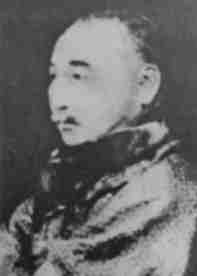 Motobu Choyu 本部朝勇(1857-1928) Motobu Choyu 本部朝勇(1857-1928)本部朝勇は琉球王族の一員で幼い頃から学問、武道、芸術の名人に囲まれて育った。王家に伝わる「御殿手(ウドンディ)」の名手で1923年に「沖縄空手倶楽部」を結成し集まった空手家にいくつかの型をシェアしたという。(「琉球王家秘伝本部御殿手」)そのメンバーに宮城長順、許田重発、摩文仁賢和(糸東流の祖)らがいた。関節技、固め技、締め技、投げ技を特徴とするサイファ、シソーチン、セイエンチン、セーパイ、クルンルンファの元型はそこで共有された、あるいは創造されたと考えられる。この倶楽部は本部の死による財政問題で消滅した。 Motobu Choyu, who was a member of the Okinawan royal family, is presumed to have taught these kata to Miyagi Chojun. As a royal, Motobu had access to many great masters of various disciplines, including martial arts and other prestigious studies, from an early age. He was also a renowned master of "Udon-di," a martial art passed down through the royal family. In 1923, Motobu established the "Okinawa Karate Research Club," which attracted many famous karate masters. Notably, Miyagi Chojun and Mabuni Kenwa,the founder of shito-ryu played active roles in the club. Motobu preserved several kata that were traditionally known within the royal family, and Miyagi Chojun is believed to have learned many of these kata from him. It is suggested that Saifa, Seisan, Seienchin, Sepai, and Kururunfa kata originated from Motobu, as they share similar techniques such as joint locks, chokeholds, tight holds, grappling, and throws, which are common in Udon-di. Motobu dedicated himself to advancing Okinawan martial arts until his death in 1928. However, his passing, combined with financial difficulties and internal divisions within the club, led to the decline and eventual dissolution of the Okinawa Karate Research Club. 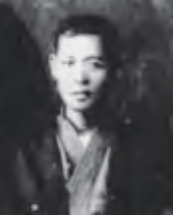 . 呉賢貴(1886-1940)は剛柔流の重要なルーツの1人である。1911年の清王朝の滅亡とともに沖縄に移住し帰化した。彼の福建白鶴拳(沖縄では鶴法とよんだ)に宮城長順は強く興味をそそられ、その影響は「転掌」や「スーパーリンペー」に見られる。彼の伝えた鶴法(カクファ)ないし白鶴(ハッファ)は比嘉世幸系統の剛柔流に保存されている。 . 呉賢貴(1886-1940)は剛柔流の重要なルーツの1人である。1911年の清王朝の滅亡とともに沖縄に移住し帰化した。彼の福建白鶴拳(沖縄では鶴法とよんだ)に宮城長順は強く興味をそそられ、その影響は「転掌」や「スーパーリンペー」に見られる。彼の伝えた鶴法(カクファ)ないし白鶴(ハッファ)は比嘉世幸系統の剛柔流に保存されている。Kenki Go(呉賢貴1886-1940)was another significant figure in Goju-ryu. Originally from China, he moved to Okinawa and became a naturalized citizen following the fall of the Qing Dynasty in 1911. His martial arts background was rooted in Fujian White Crane, a style that Chojun Miyagi found particularly intriguing. Go's strong influence is evident in the kata Tensho and Suparinpei. Additionally, the 'Kakufa; Haffa' he taught is preserved as a secret kata in Higa Seiko's lineage." 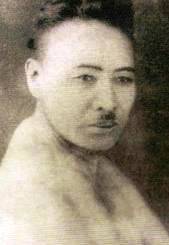 ..又又吉真豊(1888-1947)は金硬流(きんがいりゅう)の創始者。彼の師は上地流の祖、周子和の先輩で上地寛文(1877~1948)の師であるという。 ..又又吉真豊(1888-1947)は金硬流(きんがいりゅう)の創始者。彼の師は上地流の祖、周子和の先輩で上地寛文(1877~1948)の師であるという。「金」は「柔らかい」、「硬」は「硬い」という意味で剛柔流と同じ趣旨といえる。那覇手の剛柔流、上地流、劉衛流、金硬流の関係は興味深い。 Shinpo Matayoshi(1888-1947) , the founder of KimGai Ryu, became a disciple of the KimGai master through his mediation. The KimGai master was a senior to Shyu Shiwa, who was the teacher of Kanbun Uechi (1877–1948), the founder of Uechi Ryu. Notably, 'Kim' in KimGai means 'gold,' symbolizing 'softness,' while 'Gai' means 'hard' in Chinese. Thus, the term KimGai conveys a meaning similar to Goju-ryu, representing both 'hard' and 'soft.' The relationship among Goju-ryu, Uechi-ryu, Ryueiryu, and KimGai Ryu within the context of Naha-te is quite fascinating. 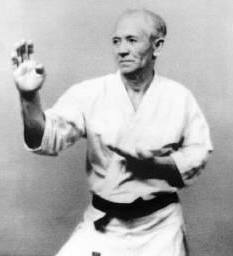 ..Seiko Higa(比嘉世幸1898~1966) ..Seiko Higa(比嘉世幸1898~1966) .比嘉世幸の父比嘉世秀と東恩納寛量は従兄弟同士で、世幸は必然的に東恩納の弟子となり、その死後は兄弟子宮城長順に師事した。宮城は剛柔流を国民体育として日本全国に普及することを目指し本土の大学生への教授を重視した。糸洲の教育空手と同じ趣旨である。対照的に比嘉は剛柔流を武術のまま捉え人脈で得た那覇手の他の型や古武道も残した。1953年に宮城が没すると最古参として剛柔流沖縄振興会を結成した。本土では彼の一番弟子として泉川寛喜が1939年から首都圏で道場活動を開始していた。 ..Higa Seiko's father, Higa Seishu, and Higaonna Kanryo were cousins. As a result, Seiko naturally became a disciple of Higaonna. After his passing, he studied under his senior disciple, Miyagi Chojun.After Higaonna's passed away, he studied under his senior disciple, Chojun Miyagi. Higaonna and Miyagi had different philosophies and kata in karate. Miyagi aimed to popularize Goju-ryu as physical education, teaching at secondary schools and universities. This was similar in spirit to the educational karate practiced by Itosu and others. In contrast, Higa viewed Goju-ryu strictly as a martial art and preserved other Naha-te kata and kobudo that he acquired through his connections. After Miyagi passed away in 1953, Higa, as the most senior disciple, established the Goju-ryu Okinawa Promotion Association. Meanwhile, on the mainland, his top disciple, Izumikawa Kanki, had already begun dojo activities in the capital region in 1939. 比嘉世幸と泉川寛喜のスーパーリンペー。一本貫手に注目。 Suparinpei by Seiko Higa and Kanki Izumikawa. Pay attention to the ippon-nukite.   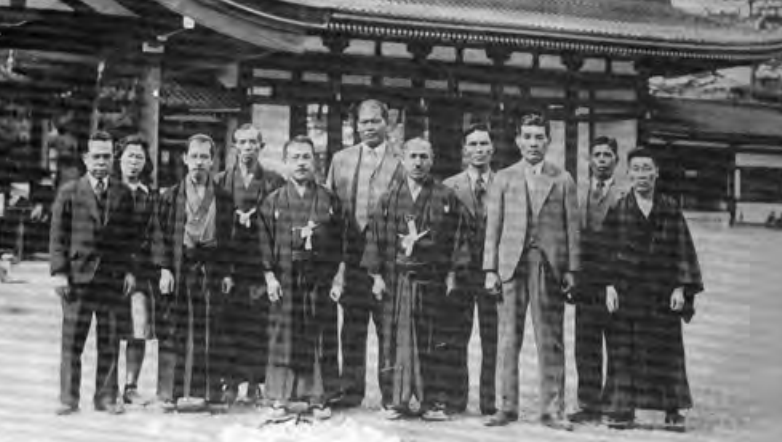 ..photo;1940 at the Dainippon Butokukai Honbu in Kyoto ..photo;1940 at the Dainippon Butokukai Honbu in KyotoKaratekas who have been awarded the "Renshi" title. 昭和15年。京都の大日本武徳会本部。左から4人目が比嘉世幸。 沖縄と本土を代表する錚々たるメンバー。彼らがひとつの団として大日本武徳会本部に赴いたことは空手史的に興味深い。この時に比嘉、又吉、山口、小西が空手術錬士号を受領した。 hiroshi Miyasato 宮里浩 fumiko Suzuki 鈴木文子 shinko Matayoshi 又吉真光 seiko Higa 比嘉世幸 gogen Yamaguchi 山口剛玄 zenko Yamashiro 山城善光 hiroyasu Konishi 小西康裕 jinan Shinsato 新里仁安 kensei Kinjo 金城兼盛 syoshin Nagamine 長嶺将真 gigou Funakoshi 船越義豪 1941年の時点で空手術の大日本武徳会教士号・錬士  号保持者は総計20名。剣道(5600名)や柔道(2073名 )に比べて著しく少なく範士号は授与されていない。 号保持者は総計20名。剣道(5600名)や柔道(2073名 )に比べて著しく少なく範士号は授与されていない。一説に武徳会附属武道専門学校(武専)で空手が教授されていたとされているが武専は剣道、柔道、弓道の中等教員養成機関(武道学士)で、国会図書館に残る当時の法令、学則、記録を確認しても空手が武専で教授されていた痕跡はない。宮城長順が指導したのは武専も含めた京都、大阪の学生の課外活動であろう。長順が「空手の段位は大日本武徳会のみが発行できる」と言ったという伝聞もあるが武徳会は剣道、柔道、弓道そして銃剣術のみに段位を発行していた。 They are distinguished representatives from both Okinawa and the mainland. Their participation in the Dainippon Butokukai as an organization is both significant and noteworthy. As of 1941, there were only 20 karate title holders in the Dainippon Butokukai, comprising 3 Kyoshi and 17 Renshi. In contrast, there were 5,600 practitioners in Kendo and 2,073 in Judo, indicating that karate was regarded as the least prestigious of the Japanese budo. There is a saying that Mr. Miyagi stated, 'Only the Dainippon Butokukai can issue Dan.' However, the Butokukai only conferred Dan ranks for three budo: Kendo, Judo, and Kyudo, and did not recognize the Dan system of other budo. ..Higa interacted with Shinko Matayoshi and Kenko Nakaima. They learned Gojuryu Karate from Higa, and Higa learned Matayoshi Kobudo and RyueiRyu Kobudo from them. Higa also learned Unsu from Choyu Motobu, which is different from today's famous Syotokan Ryu's Unsu and is called Arakaki no Unsu. Kobudo and Unsu above are not included in Chojun Miyagi's system. ..By the way, Higa was critical of the name "Goju-ryu,"' and is reported to have said, "We should have called ourselves Chinese Shaolin-ryu." 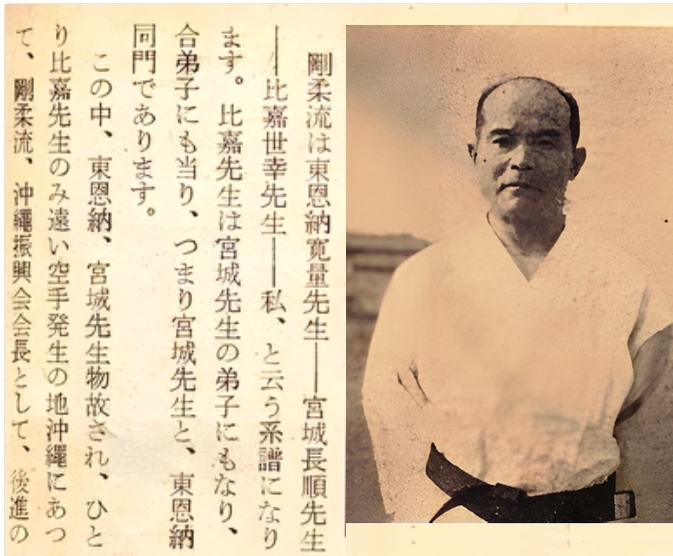 ..泉川寛喜(1908~1967) ..泉川寛喜(1908~1967) 『月刊空手道第2巻7号(昭和32年)』で彼はこう自己紹介している。 「剛柔流は東恩納寛量先生→宮城長順先生→比嘉世幸先生→私という系譜になります。比嘉先生は(東恩納の死後)宮城先生の弟子にもなり、(東恩納の)合弟子(兄弟弟子)にもあたり、つまり宮城先生と東恩納同門であります。このなか東恩納、宮城先生が物故され、ひとり比嘉先生のみ遠い空手の発祥の地沖縄にあって剛柔流、沖縄振興会会長として、後進の指導に熱心に取り組んでいます。」 東恩納寛量とは一族である。「寛」は一族の通字である。比嘉世幸と共にサイパンに渡り 1938 年に本土移住。翌年本土初の剛柔流の道場を開始した。宮城長順は京都止まりで最初に首都圏へ剛柔流をもたらした最初の空手家であった。許田重発の最初の弟子でもあるため彼の型には許田由来の挙動がある。例えば撃砕二段には許田のセーサン(東恩納のセーサン)の挙動がある。 Kanki Izumikawa,1908~1967,the first disciple of Seiko Higa, came to Japan in 1939 and initiated Goju-ryu Karate dojo activities, making it the oldest on the Japanese mainland. Chojun Miyagi traveled to Kyoto to provide instruction, but Izumikawa was the first person to bring Goju-Ryu to the Tokyo area. ..He and Kanryo Higashionna belonged to the same family. 'Kan' (寛) was a shared family character (tsūji) within the lineage.(In traditional Japanese naming customs, a 通字/tsuhji is a character that is commonly used across generations within a family or lineage, often to signify shared ancestry or clan ties.) ..He was also a student of Kyoda Juhatsu, so some of Izumikawa's kata incorporate techniques derived from Kyoda.For example, Gekisai Nidan contains movements found in Yoshida no Seisan (also known as To'on no Seisan), a version of Seisan passed down from Higashionna. 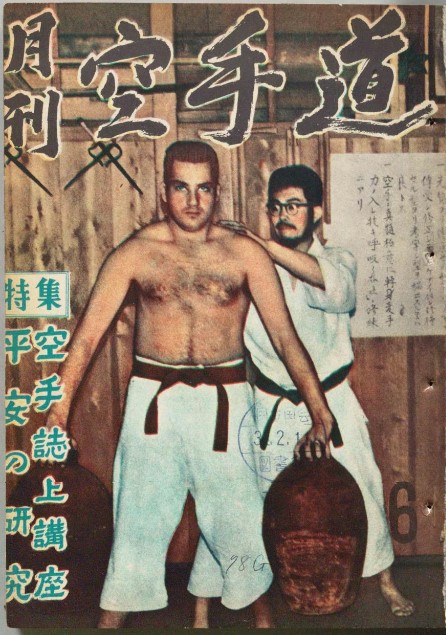 'The lineage of Goju-ryu is as follows: Sensei Kanryo Higaonna → Sensei
Chojun Miyagi → Sensei Seiko Higa → Me. Sensei Higa is a disciple of both
Sensei Higaonna and Sensei Miyagi; they were brother disciples of Sensei
Higaonna. Now that Sensei Higaonna and Sensei Miyagi have passed away,
only Sensei Higa remains to diligently teach the next generation as the
chairman of the Goju-ryu Okinawa Promotion Association in distant Okinawa. 'The lineage of Goju-ryu is as follows: Sensei Kanryo Higaonna → Sensei
Chojun Miyagi → Sensei Seiko Higa → Me. Sensei Higa is a disciple of both
Sensei Higaonna and Sensei Miyagi; they were brother disciples of Sensei
Higaonna. Now that Sensei Higaonna and Sensei Miyagi have passed away,
only Sensei Higa remains to diligently teach the next generation as the
chairman of the Goju-ryu Okinawa Promotion Association in distant Okinawa. May 1, 1957 Monthly Karatedo magazine No.5 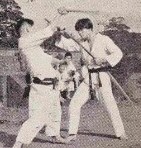 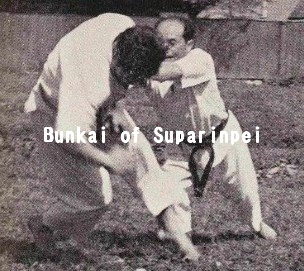 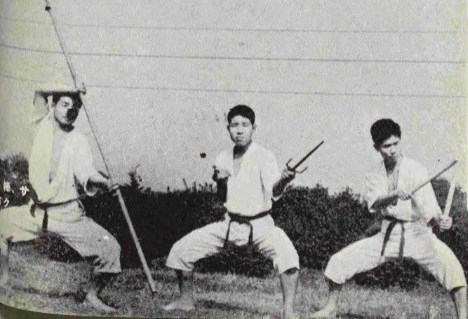 1956 1956 |
||||
| Yuzenkai 勇善会 | ||||
加藤勇(1941-2023) →detail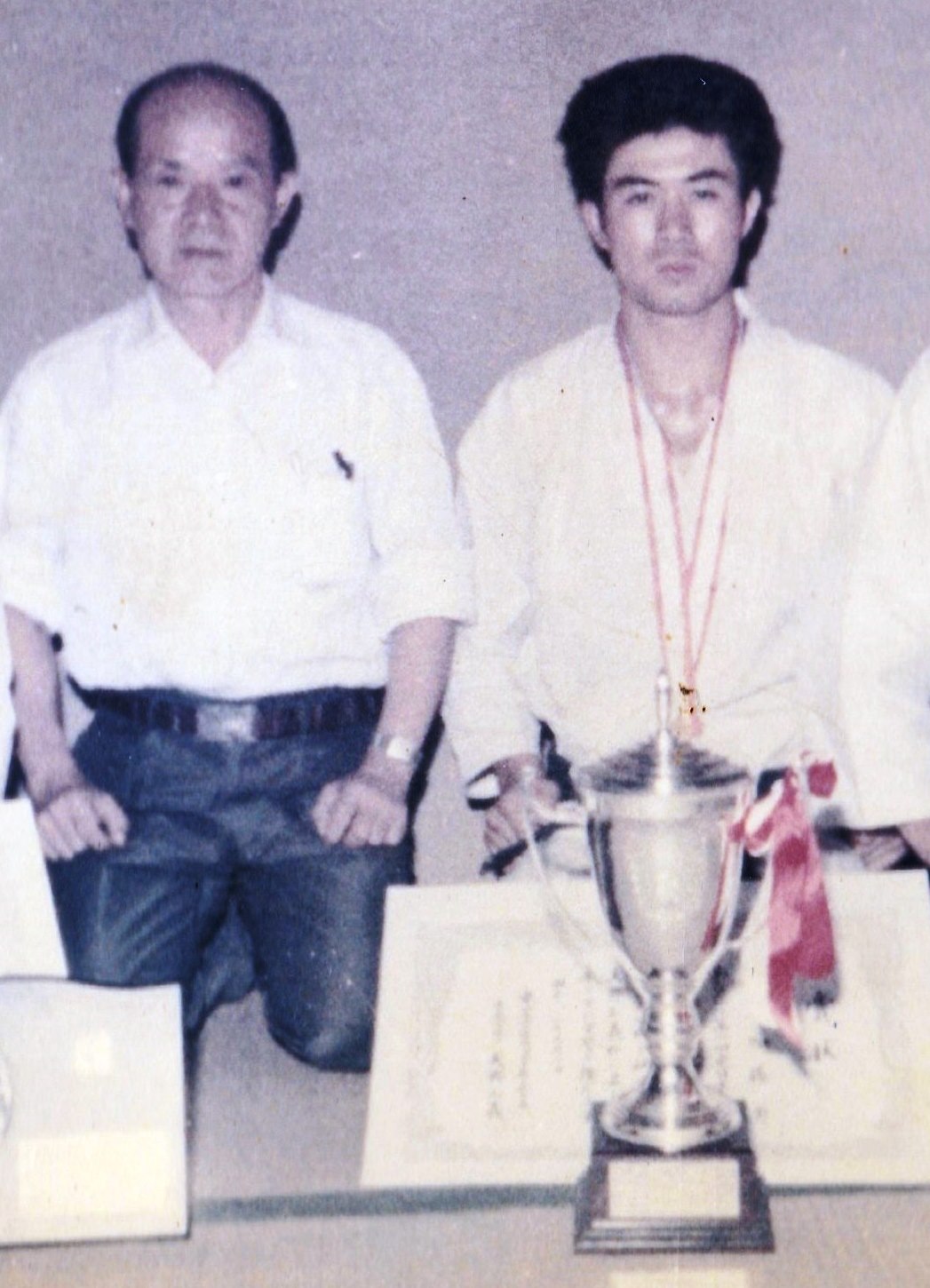 東京生まれ。法政大卒。高校時代から泉川寛喜に師事。1963年に日本空手道連合会が主催した「第1回東日本空手道選手権大会(出場選手107名)」型の部で優勝。当時西日本大会は無く全空連も存在せず、各会派ごとに競技会が行われていた中、初の流派を超えた全国大会だった。 東京生まれ。法政大卒。高校時代から泉川寛喜に師事。1963年に日本空手道連合会が主催した「第1回東日本空手道選手権大会(出場選手107名)」型の部で優勝。当時西日本大会は無く全空連も存在せず、各会派ごとに競技会が行われていた中、初の流派を超えた全国大会だった。写真 :第1回全日大会(1963)優勝後に泉川寛喜師と After winning the first All Japan Tournament (1963), with Master Kanki Izumikawa." 以降加藤は1968年にかけて型、組手ともにたびたび入賞し1960年代の泉川道場のトップファイターとして活躍した。街頭での実戦(もちろん正義からの戦い)にも強く人助けをして警察から表彰されたこともある。加藤にとっての真の空手とは複数の敵や、刃物を持った敵とも戦うことのできる空手だった。彼の自宅のガレージ道場には強くなりたい若者が他流からも集った。 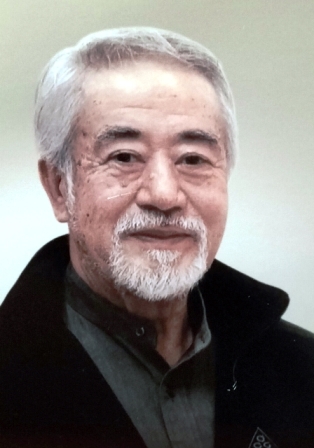 日本の空手界は泉川の死(1967)と入れ代わるように変革期に入った。1964年に設立された全日本空手道連盟(JKF)は、1969年の第1回全日本選手権大会の時点から、空手をオリンピック競技にすることを目標に掲げていた。1980年頃からJKFは「指定形」および個々の流派の特色を抑えるルールへ変容した。(私は特に投げや崩しを多用する剛柔流つぶしのルールと感じた) 日本の空手界は泉川の死(1967)と入れ代わるように変革期に入った。1964年に設立された全日本空手道連盟(JKF)は、1969年の第1回全日本選手権大会の時点から、空手をオリンピック競技にすることを目標に掲げていた。1980年頃からJKFは「指定形」および個々の流派の特色を抑えるルールへ変容した。(私は特に投げや崩しを多用する剛柔流つぶしのルールと感じた)大学や高校、実業団などの競技志向と異なり、町道場、特に沖縄系の道場では伝統と実戦を重視する考え方が根強く、空手修練の目的が根本的に異なっていた。こうした状況のなか加藤勇は自身の空手団体「活法会(真の空手を復活させる会)」を設立し活動の場を移した。 その土台の上に、長沼善秋が1985年に「勇善会(ゆうぜんかい)」を創設した。この名称は、加藤の名前「勇」と長沼の「善」に由来する。→参照.. 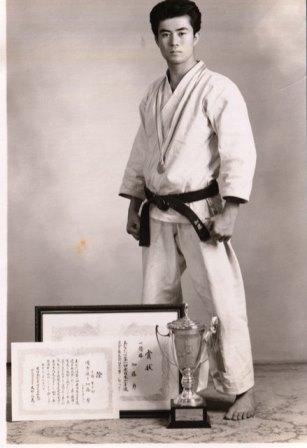 Isamu Kato (1941–2023) was born in Tokyo and graduated from Hosei University.
From his high school days, he received direct instruction from Kanki Izumikawa, the top disciple of Seiko Higa. He was the top fighter in Izumikawa's dojo and won first place in the
kata division at the 1st East Japan Karate Championship, organized by the
Japan Karate-do Rengokai in 1963. At that time, there was no JKF, and no
national tournament by many style.This was the first competitive tournament.He
is also the last generation of karateka to use Goju-ryu in real fight. Isamu Kato (1941–2023) was born in Tokyo and graduated from Hosei University.
From his high school days, he received direct instruction from Kanki Izumikawa, the top disciple of Seiko Higa. He was the top fighter in Izumikawa's dojo and won first place in the
kata division at the 1st East Japan Karate Championship, organized by the
Japan Karate-do Rengokai in 1963. At that time, there was no JKF, and no
national tournament by many style.This was the first competitive tournament.He
is also the last generation of karateka to use Goju-ryu in real fight...Around 1970, the Japanese karate world entered a period of transformation, coinciding with the passing of Izumikawa. Kato's karate was a fusion of basics, kata, kumite, and real combat. However, the Japan Karate Federation (JKF), founded in 1964, had its sights set on making karate an Olympic sport from the very first All Japan Tournament held in 1969. Around 1980, the JKF implemented standardized "sitei-kata" and sport rules that minimized individual style distinctions. Personally, I felt that these rules targeted Goju-ryu, eroding its unique characteristics and spirit. In particular, local dojos—especially those rooted in Okinawan traditions—maintained a traditional and combat-oriented mindset, with fundamentally different goals for practicing karate compared to competition-focused universities, high schools, and corporate teams. In response to this divergence, Isamu Kato established his own karate organization, Kappokai (活法会;"Society for Reviving True Karate"), and shifted his activities there. From that foundation, Yoshiaki Naganuma founded Yuzenkai, with the name derived from Kato's given name "Isamu" (勇) and Naganuma's "Zen" (善). This took place in 1985. .→referance 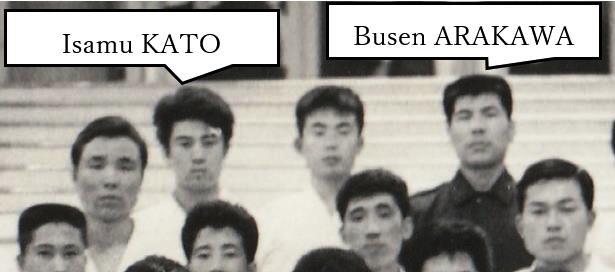 兄弟子の琉球古武道・宗幹流双節棍道(ヌンチャク)宗家の荒川武仙師(1929-2016)と。 with senior shihan Busen Arakawa(1929-2016:The landlord of Okinawa Kobudo , the founder of Sokanryu Nunchaku)  加藤の兄弟子荒川武仙(武彦)によって1965年にNHKの番組で初めてヌンチャクが全国に公開された。 加藤の兄弟子荒川武仙(武彦)によって1965年にNHKの番組で初めてヌンチャクが全国に公開された。..1965 NHK (Japan's public broadcaster)TV show. Nunchaku was first broadcast nationally on Japanese public broadcasting by Busen Arakawa,Isamu Kato's senior.  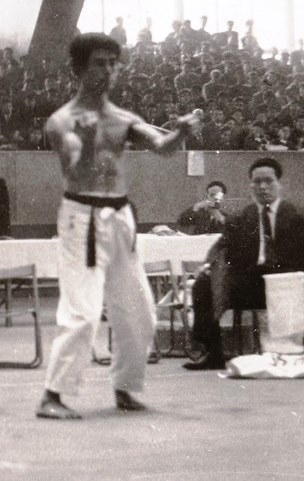 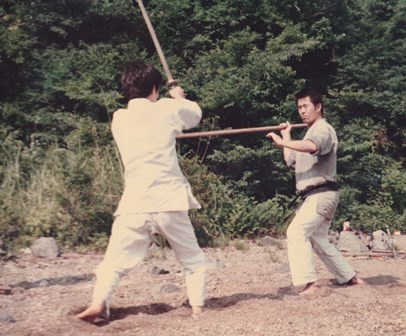 左:剛柔流の接近技法「屏風返し」で瞬間的に投げにいく加藤 中央:加藤の三戦。当初は三戦も型競技で使用できた 右:棒術対木刀。加藤は日本刀との戦いを視野にいれた稽古をしていた left;Isamu Kato attacks the opponent using the close-combat technique "Byobu Gaeshi," unique to Goju-ryu in 1965 tournament. center;Kato's Sanchin: In the past, even Sanchin was allowed in kata competitions. right;Bojutsu vs. Wooden Sword: Kato always kept the possibility of facing a Japanese sword in mind. . .. Yosiaki Naganuma 長沼善秋(1944~) 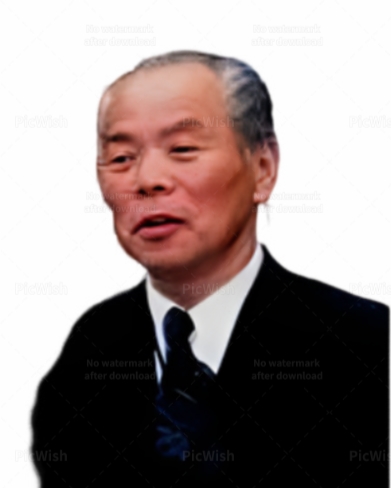 勇善会の創設者。昭和40年代の東京下町で剛柔流を実戦検証した最後の昭和世代。泉川寛喜、加藤勇、寛喜の長男泉川寛文(1943-1982)から学び、加藤の活法会に参加し、1982年に勇善会としてその意思を引きついだ。 勇善会の創設者。昭和40年代の東京下町で剛柔流を実戦検証した最後の昭和世代。泉川寛喜、加藤勇、寛喜の長男泉川寛文(1943-1982)から学び、加藤の活法会に参加し、1982年に勇善会としてその意思を引きついだ。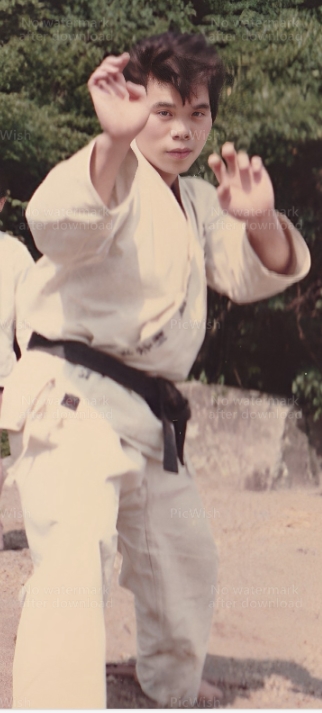 「勇善会」は加藤勇と長沼善秋の名前から一文字ずつ引用し長沼自身が命名した名称で意味は「善に勇ましくあれ」。 「勇善会」は加藤勇と長沼善秋の名前から一文字ずつ引用し長沼自身が命名した名称で意味は「善に勇ましくあれ」。Naganuma, the founder of Yuzenkai, is the last of the generation to test Goju-Ryu techniques in real combat situations in the uneasy downtown Tokyo of the 1960s and 70s. He initially learned Goju-ryu from Kanki Izumikawa, Isamu Kato, and Kanbun Izumikawa(1943-1982). After Kanbun Izumikawa's passing1982, Naganuma established his own dojo, 'Yuzenkai,' with guidance from his senior, Isamu Kato, focusing on traditional Goju-ryu, as detailed on this site. Thus, Yuzenkai was founded in 1982 for carriin on Kato's legacy. The name 'Yuzenkai' is derived from the first characters of their names: 'Yu' (勇) from Isamu (勇), and 'Zen' (善) from Yoshiaki (善秋). Its meaning is 'Be brave in doing good.'  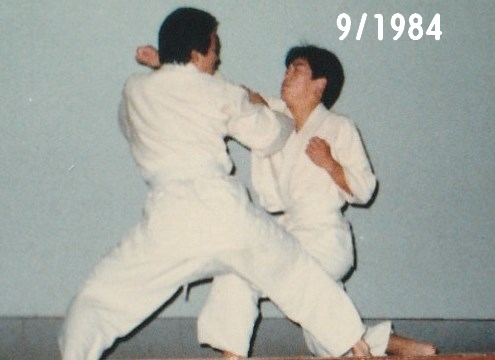 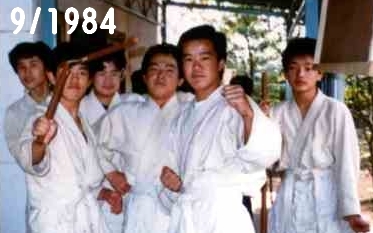   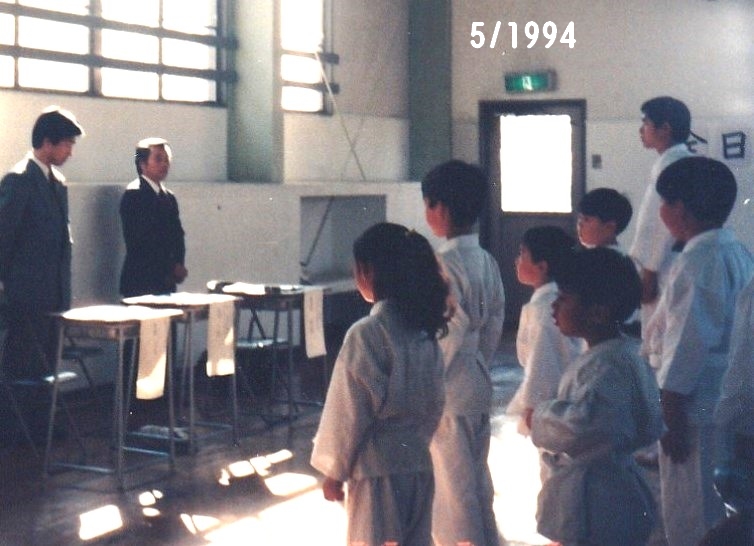 . . 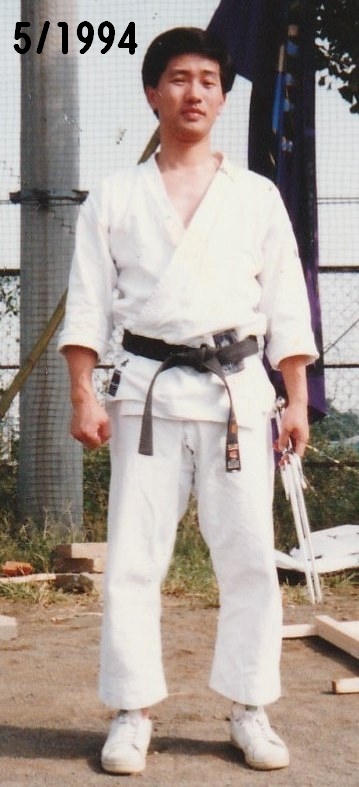 ..2013年に勇善会を継承した現館長(尾本)はインターネットを通じて継承してきた理論と技法を世界に発信することとした。 ..2013年に勇善会を継承した現館長(尾本)はインターネットを通じて継承してきた理論と技法を世界に発信することとした。勇善会発端の一因である、オリンピック競技化をめざした日本空手界の葛藤と妥協と変節についてはこちらのページを参照。 In 2013, he transferred the position of Kancho of Yuzenkai to Shihan Omoto and now serves as the adviser of Yuzenkai.In this way, the traditional combat style of Goju-ryu, as published on this website, has been passed down to the present day. For more on the conflicts and transformation of Japanese karate leading up to the Tokyo Olympics, please refer to this page. |
||||
1974年から長沼師範、加藤勇師範に師事。早大卒。大学院文学研究科修了(文学修士)。元神奈川県立高校教員(定年)。教職(社会科・空手部顧問:大会入賞指導多数)のかたわら沖縄剛柔流・沖縄古武道を海外へ指導、普及。現在12か国に支部を有する世界勇善会館長。 Kancho Omoto has been guieded Karate by Shihani Naganuma since 1974.→biography 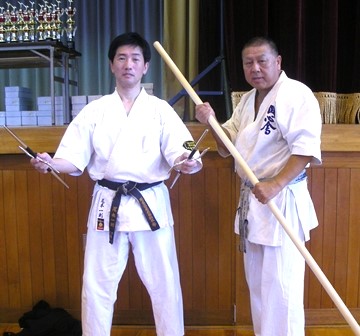 (In 2011, with the late famous professional wrestler ,Karate shihan ,kancho Masashi Aoyagi) 故 青柳政司館長(1956-2022)と。偉大なプロレスラーにしてフルコンタクト空手家そして沖縄又吉派古武道棒術の達人。フルコンと剛柔流は親和性が高い。 . 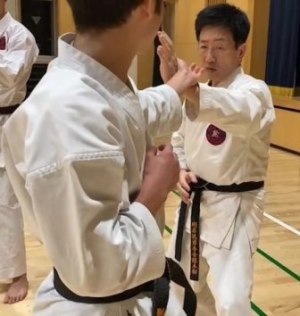 このサイトで"那覇手剛柔流"という表現をしている場面では勇善会の使命を表す意図があります。全空連式剛柔流ではない、広く那覇手の世界観の中で剛柔流を再認識し、競技目的ではなく上記の先人の技術や伝統を継承することを優先する剛柔流という意図です。いわば空手の標準化が始まった1982年以前の剛柔流を守る"ムーブメント"です。ただし少年空手の指導ではスポーツ性を優先しています。 The use of the expression 'Nahate-Gojuryu' instead of just 'Goju-ryu' on this site reflects the mission of Yuzenkai. Specifically, it aims to reaffirm Goju-ryu within the worldview of Nahate, prioritizing the preservation of techniques and traditions that have been lost due to the sportsnization of karate for future generations. Yuzenkai is dedicated to faithfully upholding the principles of Goju-ryu that existed before the standardization of Japanese karate began in 1982. Of course, this does not negate the practice of sports karate in settings aimed at children. |
||||
| returns at the page top | ||||
| yuzenkai@ab.auone-net.jp 19motoomosoraoot81@gmail.com |